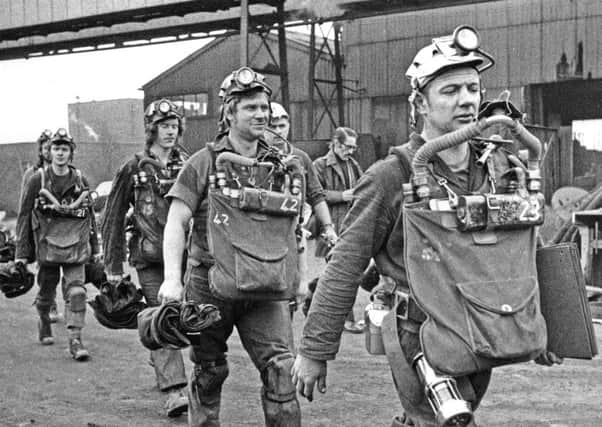Nostalgia on Tuesday: Depths of despair


One of the night shift men, who had run for his life, was fitter Keith Stone, 26. He said: “I was in the loader gate about 20 yards from the coal face when I suddenly felt the air ‘turn’. It felt strange and it was so unusual that I knew something disastrous was happening. I turned and ran hell for leather up the gateway away from the face. As I did so I heard the water break through with a roar. At one time the water was only five yards away but we beat it.”
Lofthouse colliery, about two and a half miles north of Wakefield, began production in 1877. At 2.30am on the night shift of March 20/21 1973, there were 27 men working in the dirty and dangerous depths of the South 9B seam. E Finnegan was deputy. Unknown to the men, they had cut into an abandoned shaft, releasing millions of gallons of trapped stagnant water.
Advertisement
Hide AdAdvertisement
Hide AdSome miners were washed along a ‘tidal wave’, others were half dragged, half carried by their running workmates in the race against death. Pit managers and other officials were summoned from their beds to the colliery where they quickly tried to make sense of maps to determine the extent of the tragedy underground.
It was reported that one corner of the pit face and a section of underground tunnel leading to a 1,000-yard passageway could be a life-saving sanctuary from the waters if the trapped men had reached it in time.
“If the men are alive it would be a miracle – we are hoping and praying for a miracle,” said one man directing the rescue operations.
Rescue services were mobilised, and mine rescue teams from a wide area called in. Six frogmen were brought from Cannock, Staffs, to help with operations while water from the flooded face was pumped from the pit to try to clear the roadways.
Advertisement
Hide AdAdvertisement
Hide AdHundreds of men were at the pit-head waiting for news, and extra police were drafted in. In an attempt to aid the trapped men, a specially trained team of drilling riggers and geologists began boring a small ‘lifeline’ down to the envisaged air pocket. They were drilling just off the main Batley-Wakefield road at Alverthorpe and were ordered not to smoke because of the dangers of methane gas leaking from old workings that the drill would penetrate.
As dawn had broken on March 22, coal board surveyors discovered a hole which had appeared in a ploughed field two miles from the pit yard. It was a shaft from a 130- year-old pit believed to have been 100 yards from where the floods burst down below. By 10 am a second hole appeared and a little later a third. The following day an NCB spokesman said disused mine shafts like the three which appeared near Lofthouse were dotted around the country ‘like holes in Swiss cheese’.
The wife of one of the seven miners trapped at Lofthouse broke down and wept while shaking hands with Tory Prime Minister Ted Heath on March 23. She was Evelyn Cotton, wife of Charles Cotton, 49. Mr Heath made a 30-minute visit to the area and asked about conditions down the pit. He then conferred with NCB officials before leaving and commenting: ‘There is still hope but that of course depends on the conditions down there.’
In time, the rescue attempt to free the miners failed, though not without the greatest efforts by all those concerned. One body was recovered but it was felt too dangerous to reach the other six.
Advertisement
Hide AdAdvertisement
Hide AdDr Leslie Willett, NCB deputy director-general of mining, said that he was in no doubt that the cause of the disaster was an uncharted water-filled old roadway or working connected in some way to a shaft or shafts, whose depth no one knew.
Some research had been made before work began on the mined seam in the disaster area but a crucial Victorian notebook, which would have revealed how deep abandoned adjacent workings were, was never seen. Several weeks before the disaster water was trickling down the coal face but this was attributed to a test bore hole.
The Lofthouse colliery disaster need not have happened if a more intensive search of records had been made, said Arthur Scargill, then working as a compensation agent in the Yorkshire NUM. The incident led to the Mines (Precautions Against Inrushes) Regulations 1978 (‘PAIR’), requiring “examination of records held by the Natural Environment Research Council which might be relevant to proposed workings [and] diligent enquiry into other sources of information which may be available, eg from geological memoirs, archives, libraries and persons with knowledge of the area and its history”.
“The memorial of the Lofthouse colliery disaster should be a constant reminder of the price that had to be paid for coal,” said the Bishop of Wakefield, Dr Eric Treacy, on November 24, 1974. He was speaking at the dedication service of the memorial on a site off Batley Road, Wakefield, which was directly above where the bodies of the six of the seven men who died in the disaster were believed to be entombed. Relatives and friends of the seven who died, together with representatives of the NCB and pit unions, laid flowers at the foot of the memorial, each side of which bore the name of one of the dead men.
Advertisement
Hide AdAdvertisement
Hide AdLofthouse colliery closed in 1981 after the coal was exhausted and stood derelict until reclamation began in 1989. The area was completely reshaped into Lofthouse colliery nature park featuring a large area of natural green space managed for wildlife and informal recreation.